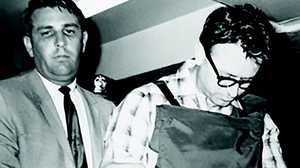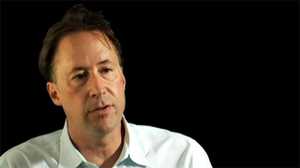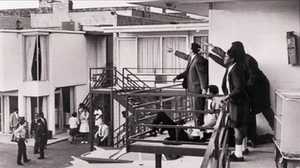King's Assassination: A Timeline

April 4, 1968
From Memphis, TN, television news broadcasts and a morning newspaper -- the Commercial Appeal, James Earl Ray discovers that Martin Luther King is staying at the Lorraine Motel, room 306.
Ray, already in Memphis staying at The New Rebel Motel, discovers that Bessie Brewer's Rooming House is adjacent to the Lorraine Motel. He decides to change his location, and checks in to Bessie Brewers.
3:30pm
Ray rents room 8 under the name "John Willard," but asks to change to room 5B, which overlooks the Lorraine Hotel. Ray discovers that the bathroom window has the best direct line of sight to room 306 at the Lorraine.
4pm
Ray purchases a pair of binoculars at the York Arms Company for $41.55, and returns to his room at Bessie Brewer's to watch for King.
5:55pm
Dr. Martin Luther King and Reverend Ralph Abernathy exit their hotel rooms after changing for dinner. The two, plus others on King's staff are to attend dinner at the home of a local minister, Reverend Billy Kyles. Emerging out of his room, King lingers on the balcony to talk to his driver, Solomon Jones, in the courtyard below.
6:01pm
Martin Luther King is shot and wounded badly.
James Earl Ray departs Bessie Brewer's Rooming House, abandoning his suitcase and rifle wrapped in a green blanket in the doorway of a nearby building, Canipe's Amusement Company. He is spotted by two patrons of Canipe's and by Charles Stephens and William Anchutz, residents of Bessie Brewer's Rooming House.
6:03pm
The shooting is radioed to police headquarters.
6:08pm
The owner of Canipe's Amusement Company informs police headquarters that a white man had run through the alley and dropped the bundle, fleeing the scene in a white Ford Mustang.
6:09pm
Barely alive, King is rushed to St. Joseph's Hospital, accompanied by Abernathy and escorted by several police on motorcycles.
6:10pm
The first police dispatch includes a description of the possible shooter as a "young white male, well dressed, believed in late-model white Mustang, going north on Main from scene of shooting."
6:16pm
King arrives at St. Joseph's Hospital, unconscious but still alive.
Ray is stuck in traffic along Highway 78, heading toward Mississippi.
6:30pm
Police find Ray's abandoned bundle in front of Canipe Amusement Co, next to Bessie Brewers Rooming House. The bundle contains the rifle, binoculars, clothing, the Commercial Appeal newspaper story that reveals King's location at the Lorraine, two beer cans, and Ray's radio.
Police investigate the rooming house and identify a John Willard in room 5B who drives a white Ford Mustang.
By this time, Ray has made his way into Mississippi.
7:05pm
Dr. King is pronounced dead at St. Joseph's Hospital.
8:15pm
The bundle left behind by Ray is handed over to the FBI.
Memphis police broadcast their information, and the manhunt King's assassin begins. Despite the proximity of Mississippi and Arkansas, the Memphis police broadcasts fail to alert these states to the alleged assassin.
By this time, Ray has traveled into Alabama where he will empty the Mustang of his belongings, dumping his expensive film equipment into a ditch by the side of the road.
Race riots break out in major black neighborhoods in more than 110 U.S. cities. In Washington, D.C. alone, over 1,000 people are injured and 6,100 are arrested. President Lyndon Johnson declares a State of Emergency, and 4,000 National Guardsmen move into Memphis to maintain order.

April 5: The Manhunt Begins
Ramsey Clark of the Justice Department and several FBI agents travel to Memphis. The investigation will turn into the FBI's largest yet, costing over $2 million and involving more than 3,500 investigators.
The FBI traces the rifle to Aeromarine Supply in Birmingham and finds the receipt signed by a Harvey Lowmeyer.
Ray drives to Atlanta on back roads and abandons his white Mustang after wiping it clear of fingerprints. After retrieving a few things from his room at the flophouse on Peachtree Street, and picking up his clothes from Piedmont Laundry, Ray boards a Greyhound bus to Detroit.
April 6
From Detroit, Ray takes a taxi across the Canadian border.
April 7
President Lyndon Johnson decrees April 7 to be a day of national mourning. King's body is viewed by mourners at Spelman College in Atlanta.
April 8
King's widow, Coretta Scott King, and dozens of national figures lead a peaceful memorial march through downtown Memphis in tribute to Dr. King and in support of the sanitation workers' strike for which King had originally been in Memphis.
Ray attempts to get a Canadian passport. His goal is to fly to Rhodesia (now Zimbabwe), a segregated country he sees as a place of refuge where he will be protected and celebrated for his deed.
April 9
King's funeral is held at Ebenezer Baptist Church. More than 50,000 people accompanied the mule-drawn coffin through Atlanta to his resting place at South View Cemetery.
April 6-10
From the evidence left behind in Ray's bundle, the FBI believe the killing was a conspiracy between three men: Eric S. Galt, Harvey Lowmeyer, and John Willard.
The FBI traces laundry tags on Ray's shirt and shorts to Home Service Laundry in Los Angeles, CA, who tells them the name on the receipt is Eric S. Galt. They also trace a pair of pliers to Rompage Hardware, two blocks from Home Service Laundry.
April 11:
The Investigation of Eric Galt
The FBI finds a white Ford Mustang registered to Eric Galt in an Atlanta parking lot. Through a sticker on the Mustang's window, the FBI realize the car was serviced in Los Angeles the previous February. The garage's records give the address for Ray's Serrano apartment in LA.
Further investigation into Eric S. Galt takes investigators to Birmingham, AL, where neighbors reveal that Galt took dancing lessons. This information, when coupled with the fact that Galt's Mustang was traced to Los Angeles, led investigators to a photograph of Eric Starvo Galt at a dance studio in LA.
Finding Ray's old boarding house in Birmingham, the FBI gets more information on the Mustang. They locate and contact the car's previous owner.
Los Angeles post office records reveal that Galt moved from the Serrano apartment to St. Francis, and that he put in a change of address on March 17th for Atlanta.
April 12-16
The FBI gets a photo of Eric Galt from the International School of Bartending.
Investigators examine all money orders recently purchased in LA, and finds one from Galt to the Locksmithing Institute. The FBI discovers that Ray completed his first locksmithing lesson in Montreal, and a later lesson in Atlanta, where a local address is listed.
Searching Galt's room in Atlanta, the FBI finds an Atlanta map with pencil marking showing he stalked King's movements. Four places are circled on this map -- Ebenezer Baptist Church, SCLC headquarters, King's home and the Capitol Homes housing projects. The map also provides detectives with a clear left thumb print.
April 17: Hoover's Fingerprint Hunch
The FBI issues a fugitive warrant for Eric Starvo Galt. They publish the bartending photo of "Eric Galt," announcing that the man in the photo is wanted in connection with King's assassination.
Investigators have begun to believe that one man using various aliases committed the murder, as all the prints left behind belonged to a single man. Hoover orders finger print comparisons to all known fugitives in the country -- a collection of over 53,000 prints.
The next day, federal detectives will begin manually matching fingerprints.
April 19
At around the 700th fingerprint they come across, detectives find a match - James Earl Ray. The FBI immediately distributes Ray's name and mug shot on posters around the country, announcing that Eric Starvo Galt is in fact Ray.
Investigators include both Mexican and Canadian authorities in the case, as the FBI has proof that Ray visited both countries while on the lam.
April 21: Tracking Down Ray
The ABC Show "The FBI" broadcasts a short appeal for public assistance in the fugitive investigation of James Earl Ray.
April 24
Ray obtains a passport from Canada under the name of George Sneyd and purchases a roundtrip ticket from Toronto to London.
May 6
Ray flies to London and then exchanges his return ticket to Canada for a new ticket to Lisbon, Portugal. His ultimate destination is Rhodesia, Africa, where he wants to be a mercenary. Rhodesia, which will become "Zimbabwe" in 1980, observed no extradition treaty with the United States.
May 7
Ray arrives in Portugal and learns he had missed a boat to Africa by just two days.
May 9
The FBI's trail has turned cold, and after more than a month of frustration, they consider microphone surveillance of Ray's brother and sister, John Ray and Carol Pepper.
May 17
Ray returns to London, looking for another way into Rhodesia. With money running out, Ray decides to rob a jewelry store.
May 27
Ray attempts to rob a Paddington jewelry store owned by Maurice and Billie Isaacs. After encountering unexpected resistance from the Isaacs', Ray takes off down the street, empty handed.
June 1
After looking at 175,000 passport applications, the Royal Canadian Mounted Police find a match between the photograph of "Eric Galt" and an application for a "George Ramon Sneyd." Investigators track the information on the passport to 962 Dundas Street, where Ray had used the alias Paul Bridgman before he left the country. "Sneyd"'s passport enables investigators to then track Ray's trail from Toronto to London to Portugal and back to London.
The FBI releases Ray's name and updated list of aliases to airports around the world for the "Watch and Detain" list.
June 4
Ray attempts to rob the Trustee Savings Bank in Fulham, England but is startled when the teller accidentally kicks a metal box, producing a sound similar to a gunshot. Ray runs from the bank with 95 pounds, the equivalent of only $240 U.S. dollars.
June 8
At Heathrow Airport, Ray attempts to buy a ticket on European Airways Flight 466 to Brussels, Belgium. An immigration officer spots Ray's two passports and, concerned, finds "Ramon George Sneyd" on the "Watch for and Detain" list. Ray is quickly arrested and the FBI immediately begins the process for extradition. The speculation begins whether he acted alone or was part of a conspiracy.
June 11: Extradition and Guilty Plea
Ray protests extradition to the United States and requests F. Lee Bailey as his lawyer, the famous Boston trial attorney who had successfully defended accused murderers Sam Sheppard, the "Boston Strangler" Albert DeSalvo, and other notorious suspects. Bailey refuses to take the case.
June 27
Ray attends his extradition hearing in London and preliminary evidence is laid out against him.
July 3
The United States is granted extradition.
July 8
Journalist William Bradford Huie strikes a deal with Arthur J. Hanes, Sr., an Alabama defense attorney, in which Huie will provide the money for Ray's defense in exchange for exclusive rights for a book.
July 19
James Earl Ray is extradited to in Memphis, TN, arriving in a bulletproof vest and heavy "safety pants."
November 10
After Ray learns that Hanes believes Ray faces no chance of acquittal, Ray fires his lawyer.
Two days later, in an interview for Look magazine, Ray alleges that a fellow con man named Raoul was the perpetrator and actual assassin of Dr. King, and Ray argues he was simply the getaway driver.
February 11, 1969: The Years Following 1968
Ray hires Percy Foreman as his new attorney, a Texas lawyer who was famous for defending 778 accused murders and successfully acquitting 705 of them. However, after listening to his client for over 30 hours, Foreman tells Ray that his case is hopeless. Ray finally agrees to plead guilty.
March 10, 1969
James Earl Ray pleads guilty to killing Martin Luther King, Jr. and is sentenced to 99 years in Brushy Mountain State Penitentiary in Tennessee.
March 13, 1969: Ray's Recantation
Ray recants his plea, claiming he was coerced into giving a guilty plea. Ray will maintain his innocence for the rest of his life and will come up with various conspiracy theories explaining King's assassination.
April 17, 1969
Ray files a formal petition for a new trial, which will be denied by the court after a hearing in late May.
May 1971
Planting a dummy in his bunk bed, Ray attempts to escape from prison through a steam tunnel. He is caught in the process.
February 1972
Ray's second attempt at escape is less successful when he is caught cutting a hole through the ceiling near his work area.
January 1974 - May 1978
Despite Ray's repeated appeals, four different courts uphold the initial ruling that Ray's Constitutional Rights have been upheld and deny Ray the right to a trial.
June 10, 1977
Ray escapes from prison using a makeshift ladder to scale the 14-foot high prison wall. Three days later he will be captured, and one year is added to his sentence making the total 100 years.
August 16, 1978
Ray testifies before the House Select Committee on Assassinations. After careful review of the evidence, on December 30 the committee will conclude that Ray acted alone despite "circumstantial evidence of a conspiracy."
August 10, 1979
After a meeting with Ray and his attorney, Reverends Jesse Jackson and James Lawson announce they do not believe Ray was responsible for King's death.
November 9, 1979
Ray escapes from Brushy Mountain State Prison again, but is captured when a guard spots him crawling along the base of the prison wall under a camouflage blanket.
December 1993
Lloyd Jowers, the owner of Jim's Grill that overlooks the Lorraine Motel, states that he was part of a conspiracy to kill Dr. King. On ABC's Prime Time Live, Jowers claims mobsters gave him $100,000 to plan King's assassination, and that someone other than Ray fired the shot that killed the civil rights leader. A subsequent investigation ruled that Jower's claims had no merit.
December 1996 - April 1998: Illness and Final Days
Debilitated by kidney and liver disease, Ray is hospitalized over 15 times and slips into comas on three occasions.
April 23, 1998
James Earl Ray dies in prison from kidney and liver disease at age 70. His liver failure is caused by the hepatitis-C he had contracted from blood transfusions received after being stabbed in prison.
November 16 - December 8, 1999
The King family still believes that Ray did not act alone, and sues Lloyd Jowers for the wrongful death of Martin Luther King, Dr. Coretta Scott King testifies in the trial, and the lawsuit ends with a $100 claim paid toward the King family in damages.
June 2000
U.S. Attorney General Janet Reno conducts the fourth investigation into Ray's appeal, but finds no evidence of conspiracy or reason to re-open the case.









